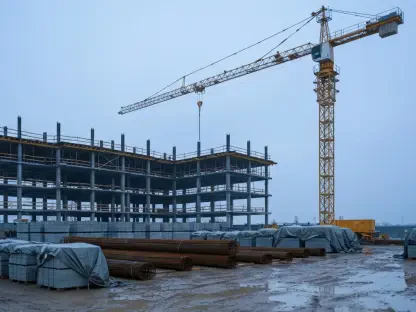In Melbourne’s bustling urban landscape, where real estate prices are skyrocketing and rental options remain scarce, a fresh approach to housing solutions emerges. This innovative initiative takes inspiration from social dynamics and aims to alleviate the rent crisis by employing a unique matchmaking strategy akin to speed dating. Organized by Local, a pioneer in the build-to-rent sector, this concept is being piloted at the newest Kensington complex. Here, traditional apartment settings are reimagined into spaces where residents not only share roofs but also connect meaningfully. This matchmaking process is a strategic response to the burgeoning demand for affordable housing as property prices continue their relentless climb. Nowadays, many seek viable alternatives to owning houses in Melbourne’s constrained property market, emphasizing the need for collaborative living arrangements and harmonious cohabitation. Participants at these events navigate the complexities of housemate compatibility, guided by the vision of fostering sustainable tenant relationships that benefit both individuals and the community.
Dynamic Housemate Pairing
Central to this initiative are the cleverly termed “Housemate Huddles,” gatherings designed to match potential flatmates through structured yet engaging interactions. The approach diverges from conventional methods, focusing instead on compatibility in lifestyle and personal habits rather than romantic interests. In a model reminiscent of speed dating, participants engage in various activities, including property tours and lively social gatherings where shared meals and conversations enrich the experience. Matchmakers, equipped with insights from initial online assessments, facilitate connections that aim to bypass the awkwardness typically associated with meeting strangers. This dynamic pairing method not only eases the tenancy process but also contributes to creating livable environments where residents thrive. The focus on compatibility underscores a forward-thinking strategy in Melbourne’s housing market, encouraging meaningful interactions among residents who share similar values and lifestyles. By reducing barriers to shared living and prioritizing tenant comfort, these events promise to redefine how renters approach cohabitation in high-demand urban areas.
Build-to-Rent Model Impact
Amidst the landscape of rising property prices and limited housing options, the build-to-rent model emerges as a promising trend within the real estate sector. At its core, this model prioritizes long-term rental properties over traditional selling strategies, introducing a new dynamic to Melbourne’s housing market. Developments like Local: Kensington reflect this trend, offering not only living spaces but also integrated amenities that cater to contemporary urban lifestyles. Such developments address housing shortages and contribute to the diversification of available rental options vital in today’s market climate. While inner-city living drives rental costs upwards, the build-to-rent approach provides relief by stabilizing rental pricing amidst economic fluctuations. This trend parallels measures taken during historical financial crises to ensure housing affordability aligns with income growth. With the inclusion of facilities that enhance community interaction and personal well-being, these complexes serve as catalysts for sustainable urban living without compromising quality.
Community-Centric Living
A central feature of the Kensington complex and similar developments is the emphasis on communal living spaces that foster social connections. These areas are designed to blur traditional apartment boundaries, enhancing residential experiences through shared interactions. Amenities such as cinemas, fitness centers, working hubs, and communal kitchens create environments where tenants engage in shared activities that promote a sense of belonging. This design approach not only supports social well-being but also aligns with broader societal trends towards inclusive and supportive housing solutions. By nurturing diverse and vibrant communities, these developments attract varied groups, from newcomers seeking rental spaces to those exploring shared living for the first time. Specialty events tailored to different demographic groups, including women-only nights and gatherings aimed at the LGBTQ+ community, emphasize inclusivity and align with strategies backed by governmental bodies to advocate for holistic housing solutions. The integration of social spaces in rental complexes reflects a growing acknowledgment of communal interaction as vital to enhancing residents’ living conditions.
Economic and Social Benefits
With explicit consideration to rental costs, which span a wide range, build-to-rent complexes offer a financially viable option in Melbourne’s competitive housing market. Weekly rents at the Kensington complex are detailed, with prices for two-bedroom apartments starting at $822 and three-bedrooms reaching upward of $1258. This framework provides renters an alternative amid fluctuating housing markets, positioning build-to-rent as both a cost-effective and practical solution. Pre-equipped apartments feature essential appliances, illustrating the commitment to convenience and high living standards. By alleviating rental burdens, developers aim to sustain tenant turnover while fostering long-term, stable communities within city limits. The focus on providing quality housing environments enriched with community-centric amenities marks a significant shift toward socially responsible urban planning. This approach underscores the importance of integrating modern lifestyle considerations and affordability in housing strategies that aim to enhance Melbourne’s real estate landscape for future generations. As these developments flourish, they paint an optimistic narrative for transforming urban living into a more accessible, inclusive, and sustainable model.
Future Considerations for Urban Housing
In Melbourne’s bustling urban scene, where real estate prices are skyrocketing and rental options are limited, a novel housing solution is taking shape. This innovative approach, inspired by social dynamics, seeks to address the rent crisis with a matchmaking strategy similar to speed dating. Spearheaded by Local, a leader in the build-to-rent market, this concept is being tested at the new Kensington complex. Here, conventional apartment living is transformed into communal spaces where residents share more than just a roof—they build meaningful connections. This matchmaking strategy is a targeted response to the growing demand for affordable housing as property prices continue to soar. With many looking for alternatives to home ownership in Melbourne’s tight market, there’s an increasing emphasis on collaborative living arrangements for harmonious cohabitation. These events guide participants in navigating housemate compatibility, with the aim of building sustainable tenant relationships that benefit both individuals and the wider community.









